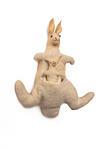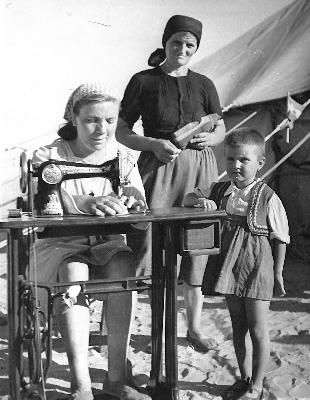Toy kangaroo
Production date
1945
See full details
Details
Description
This toy kangaroo was made in a Displaced Persons camp by a survivor of the Bergen-Belsen concentration camp. It was produced in an occupational therapy class using recycled or donated clothes.
Crafts such as toy/doll-making kept skills active, passed the time and kept cultural identity alive. These creative items can also be seen as symbols of hope and survival. While this item was given as thank-you gift to a British Red Cross civilian relief volunteer, Enid Fordham, handcrafted items like these were often sold for income or used in exhibitions or competitions.
Crafts such as toy/doll-making kept skills active, passed the time and kept cultural identity alive. These creative items can also be seen as symbols of hope and survival. While this item was given as thank-you gift to a British Red Cross civilian relief volunteer, Enid Fordham, handcrafted items like these were often sold for income or used in exhibitions or competitions.
Collection Type
Objects
Media/Materials
History
SECOND WORLD WAR REFUGEES AND DISPLACEMENT
The Second World War displaced around 165 million people. The changing nature of warfare during this conflict, including advances in technology bringing increasingly devastating weaponry, resulted in a dramatic increase in civilian suffering. The Geneva Conventions protected medical personnel, wounded troops and prisoners of war. However, there were few rules which specifically protected civilians in wartime. Millions of civilians in Europe and Asia were deported, taken hostage, and forced into concentration and internment camps.
As the war drew to a close, millions of displaced people were trying to get home. However, many people had no homes to return to. Others, fearing for their lives, did not want to go back. The British Red Cross assisted with repatriations and played a significant role in reuniting families separated by the conflict, both during and after the war.
BERGEN-BELSEN DISPLACED PERSONS CAMP
Six days after the liberation of the Bergen-Belsen concentration camp on 15 April 1945, teams from the British Red Cross arrived at the camp to help aid the civilians. The site of the concentration camp became a Displaced Persons camp, and the survivors, from all over Europe, were given the status of ‘Displaced Persons’ (DPs) by the Allies, giving them the right to special assistance and care.
Most of the survivors returned to their countries of origin, but many- mainly Jewish and Polish prisoners- remained in Bergen-Belsen as they could not or did not want to return to their former homelands. Although the people in these camps faced many challenges, they sought to rebuild their shattered lives by creating flourishing communities.
The Second World War displaced around 165 million people. The changing nature of warfare during this conflict, including advances in technology bringing increasingly devastating weaponry, resulted in a dramatic increase in civilian suffering. The Geneva Conventions protected medical personnel, wounded troops and prisoners of war. However, there were few rules which specifically protected civilians in wartime. Millions of civilians in Europe and Asia were deported, taken hostage, and forced into concentration and internment camps.
As the war drew to a close, millions of displaced people were trying to get home. However, many people had no homes to return to. Others, fearing for their lives, did not want to go back. The British Red Cross assisted with repatriations and played a significant role in reuniting families separated by the conflict, both during and after the war.
BERGEN-BELSEN DISPLACED PERSONS CAMP
Six days after the liberation of the Bergen-Belsen concentration camp on 15 April 1945, teams from the British Red Cross arrived at the camp to help aid the civilians. The site of the concentration camp became a Displaced Persons camp, and the survivors, from all over Europe, were given the status of ‘Displaced Persons’ (DPs) by the Allies, giving them the right to special assistance and care.
Most of the survivors returned to their countries of origin, but many- mainly Jewish and Polish prisoners- remained in Bergen-Belsen as they could not or did not want to return to their former homelands. Although the people in these camps faced many challenges, they sought to rebuild their shattered lives by creating flourishing communities.
Catalogue Number
1535/1
Associated Person and Role
Enid Fordham
Associated Person
Subject auto tags
Object Types
Part of 1 highlight set
Share
All images are the property of the British Red Cross Museum and Archives (unless otherwise indicated), and cannot be used without permission. For queries about permission to use images, please contact enquiry@redcross.org.uk.


